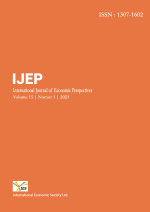Effect of climate changes on the Coorg Mandarin-An overview
Abstract
Climate change is the drastic and hazardous problem in the world now a days and these effecting to agriculture directly or indirectly. Climate change impact on different environmental components-land, soil, water, atmosphere, biosphere are creating very serious and effective situation.These are changing the public scenarios. Agriculture is arguably the most important sector of the economy that is highly dependent on climate. Climate change is just one of vital factors that may affect global orange production. It is nonetheless likely to be one of the most important ones. It is true that a great degree of uncertainty still exists with regard to how individual producing regions will be affected, and how climate change will affect overall orange production. However, experts expect some changes to occur, and these could be significant in some regions. This paper throws light on impact of climatic conditions on Coorg orange production.
References
Anonyms, 2019-20, Horticultural crop statistics of Karnataka state at a glance.p.42
Jayanthi Mala B.R., et.al.: Role of climatic factors on citrus psylla Diaphorina citri Kuwayama (Psyllide: Hemiptera) in Coor Mandarin, Citrus reticulate Blanco, Current Biotica 9(1):45:53, 2015.
Lengnick, Walthall C, Hatfield J, Marshall E, 2013, Climate change and agriculture in the united states: Effects and adaption. USDA, Washington DC.
Prestidge RA, Pottinger RP(1990) ‘The Impact of Climate Change on Pests, Diseases, Weeds and Beneficial Organisms Present in New Zealand Agricultural and Horticultural Systems.’ (MAF Technology, Ruakura Agricultural Centre: Hamilton, New Zealand).
Atkinson D. (1993) ‘Global climate change, its implication for crop protection.’ (British Crop Protection Council Monograph No 56. BCPC, Surrey, UK)
Manning WJ, Tiedemann AV, 1995. Climate-change – potential effects of increased atmospheric carbon-dioxide (CO2), ozone (O3), and ultraviolet-B (UV-B) radiation on plant-diseases. Environmental Pollution88, 219-45.
Prasad/Kumar: A handbook of fruit production, Vol-II: Fruit Cultivation, published by Agrobios, Chopasani Road, Jodhpur-342003, India, 2016, p.282.
The Intergovernmental Panel on Climate Change, 2006, IPCC National greenhouse gas Inventories Programme, Kamiyamaguchi, Hayamas, Kanagawa, Japan.
District disaster management authority, 2019, Kodagu district, Karnataka, India, p.6
F.A.O. Production year book, Table 57, 2020, p.347
Rajput CBS & Sri Harbabu R, 1985, Citriculture, p.69
Mohanta D.K and Konwar A., 2014, Production and marketing of orange in Assam-A study on Doomdooma region of Tinuskia district, Journal of Agriculture and Life Sciences, 1(1): 82-90.
Prasad/Kumar., 2016, A handbook of fruit production, Vol-II: Fruit Cultivation, Published by Agrobios, Chopasani Road, Jodhpur-342003, India, p.282-283.
Kodagu District Statistical at a glance, 2018-19, p.37.
Kodagu district administration, 2018, Kodagu district, Karnataka, India.
The New Indian Express daily, Kodagu orange growers worried over fruit drop, published on 4th November 2019.
Ranjith Singh, 1995, Fruits, Published by the Director, National Book Trust, A-5, Green Park, New Delhi, India, p.89.
Tripathi P.C.: Production Technology of Coorg Mandarin,Central Horticultural Experiment Station, Chettalli, Kodagu p.3
Tripathi P.C.: Production Technology of Coorg Mandarin,Central Horticultural Experiment Station, Chettalli, Kodagu p.3.
Sing S & Singh D. 1957, Ind.Hort., 1(2):12-16.
Gazeteer of India, Karnataka State, 1993, Kodagu District. p.240.
Gazeteer of India, Karnataka State,1993, Kodagu District. p.240.
De L.C, 2017, Citrus rejuvenation in N.E. Region of India, International Journal of Agricultural Science and research, 7(2): 325-342.
Rajput CBS & Sri Harbabu R, Citriculture,1985, p.71
Ramachandra T.V., Energy & Wetlands groups, Centre for Ecological Sciences, Indian institute of science, Kodagu, Karnataka, India.
Col.Muthanna of Coorg Wildlife Soceity(CWS), Kodagu district, Karnataka, India.
District Disaster Management Authority, 2019,Kodagu district, Karnataka, India, p.29.
Ashwini M Sripad., Sept.1, 2018, Damage will leave you deprived of Kodagu oranges, published in the new Indian Express daily.
Virendra Kumar, Chief Scientist at Krishi Vignyana Kendra, Gonikoppal, Kodagu, Karnataka, India.
Rama Rao, Gaalibeedu village, Madikeri, Kodagu, Karnataka, India.
Subbaiah, Ibnivalavadi Village, Kodagu, Karnataka, India.
Macchamada Kanda Bheemaiah., Ibnivalavadi Village, Kodagu, Karnataka, India.
Gita Agnihotri, Director of India, Meteorological Department, Karnataka.
Geological Survey of India(GSI) report, 2018.
Disaster Management Report, 2018, Kodagu district, Karnataka, India, p.6.
Pande, S., and Shanna, M. 2010. Climate change: Potential impact on chickpea and pigeonpea diseases in the rainfed semi-arid tropics (SAT). In: 5th International Food Legumes Research Conference (IFLRC V) and 7th European Conference on Grain Legumes (AEP VII) April 26-30, 2010, Antalya, Turkey.
Ranjith Singh., 1995, Fruits, published by The Director, National Book Trust, India, p.90.
Singh A.K, Meeti N.T. and Mandal N, 2016, Khashi mandarin: its importance, problems and prospects of cultivation in North-eastern Himalayan region, International Journal of Agriculture, Environment and Biotechnology, 9(4):573-59210.5958/2230-732X.2016.00076.0.
Published
How to Cite
Issue
Section
Allows users to: distribute and copy the article; create extracts, abstracts, and other revised versions, adaptations or derivative works of or from an article (such as a translation); include in a collective work (such as an anthology); and text or data mine the article. These uses are permitted even for commercial purposes, provided the user: gives appropriate credit to the author(s) (with a link to the formal publication through the relevant URL ID); includes a link to the license; indicates if changes were made; and does not represent the author(s) as endorsing the adaptation of the article or modify the article in such a way as to damage the authors' honor or reputation. CC BY







